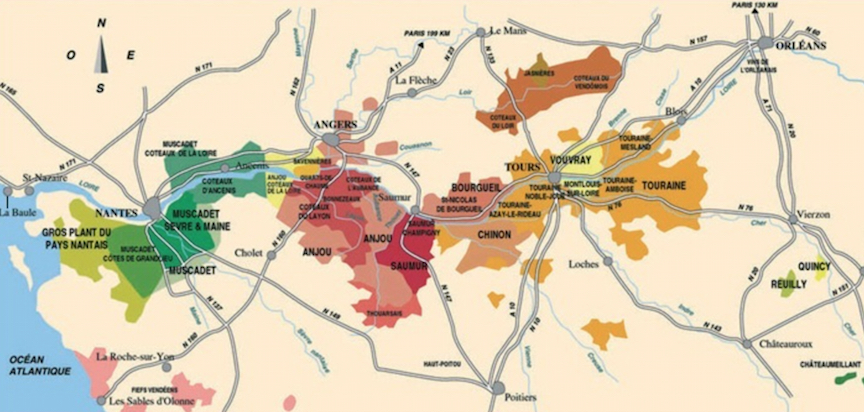
The Loire Valley, one of the most underestimated wine regions in France, is referred to as Jardin de la France (Garden of France), and was designated a World Heritage Site in 2000. The most notable appellations exist from Pays Nantais on the Atlantic Coast to the Central Vineyards of the Upper Loire, which stand at the exact geographical center of France. The climate of the Loire Valley varies from wet and maritime in the west, to continental in the east. The diversity of soil, terroir, and climate of the Loire Valley are the key factors for producing interesting and promising wine in the region. The Loire Valley produces more white wine than any other area in France, with Chenin Blanc, Sauvignon Blanc, and Melon de Bourgogne making up the majority of white varietals planted.

Located in Pays Nantais on the Atlantic coast of the Loire Valley and near the city of Nantes is the wine region Muscadet. The wet and cool maritime climate of Muscadet, combined with soil dominated by sand, limestone, and schist, provide the perfect conditions for growing Melon de Bourgogne, a white varietal known for its resistance to cold and frost. Melon de Bourgogne, originating from Auxerrois, Burgundy, is a cross between Gouais Blanc and Pinot. The varietal was introduced to the region after a severe frost in 1709 killed many of the preexisting vines, and local vignerons replanted with Melon de Bourgogne. The grape now calls the region home, although it is cultivated in other parts of the world as well. Known as Melon in the United States, several producers in Oregon and California have produced wines from this grape.
There are four appellations that exist for the production of Melon de Bourgogne: Muscadet AOP, Muscadet Coteaux de la Loire AOP, Muscadet Cotes de Grandlieu, and Muscadet Sèvre-et-Maine AOP, the most well-known of the Muscadet appellations. Nearly half the Sèvre-et-Maine production is bottled sur lie, a process that adds complexity, richness, and a slight sparkle to the finished wines. Sur lie wines are aged on their lees over the winter, and are bottled directly off the fine lees (without filtering) between March first and November thirtieth of the year following the harvest. A good quality Muscadet is typically consumed in its youth, however it does have aging potential when it is properly made. In general, the wines are characterized by light, crisp notes of apple and citrus on the nose, minerality such as saline or sea spray on the palate, and racy acidity. It is a great wine to enjoy on a hot, summer day, and it pairs perfectly with oysters, shellfish, white fish, and rocket salad.
One of the most well-known producers in Muscadet Sevre-et-Maine, Domaine de la Pepiere, believes that quality wine depends on the quality of the vine. They switched to organic farming in 2007, and use biodynamic techniques to enhance and support the microbial life of the soil in the vineyards. Their wine spends two to four years on its lees, giving it a more oily texture, toasty aromas, and candied fruit flavor.
Located in Muscadet Cotes de Grandlieu is Domaine du Haut Bourg, another well-known Muscadet producer. The estate was built by fourth generation winemakers, and is currently run by brothers Nicolas and Hervé Choblet. They have been using 30 to 60-year-old vines to produce their Muscadet, as these old vines are highly valued in providing structure and richness to the wines. In addition to making a regular Muscadet sur lie, they also produce a special cuvee aged a minimum of seven years on the lees, showing the amazing aging potential of their wines.
Muscadet may not yet enjoy the same recognition as other Loire varietals like Sancerre or Pouilly Fume, but it sure has its own audience. Why not try Muscadet instead of Chablis or Sauvignon Blanc with your next seafood meal? You might find yourself a new favorite.









